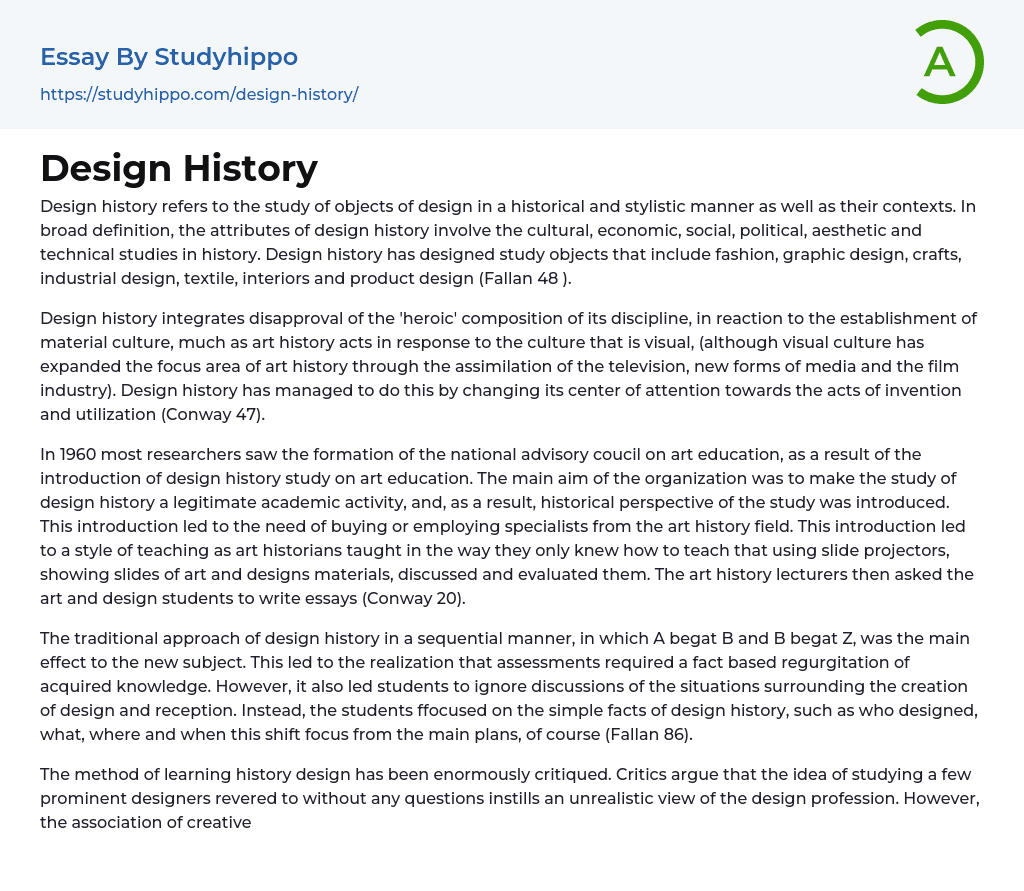Design history involves analyzing design objects and their contexts from historical and stylistic perspectives. It encompasses various fields such as cultural, economic, social, political, aesthetic, and technical studies within the realm of history. Design history covers a wide range of disciplines including fashion, graphic design, crafts, industrial design, textiles, interiors, and product design (Fallan 48).
Design history, similar to art history, disapproves of the 'heroic' organization of its discipline in response to the establishment of material culture. However, the expansion of visual culture through television, new media forms, and the film industry has broadened the focus area of art history. Design history has achieved this by shifting its attention towards invention and utilization. In 1960, design history study was introduced to art education which led to the creation of the national advisory council on art education w
...ith a goal to legitimize design history as an academic activity and introduce a historical perspective. This resulted in specialists from the art history field being acquired or employed. Art historians used slide projectors to showcase art and design materials while engaging in discussions and evaluations. Art and design students were then required to write essays based on these presentations. Consequently, this traditional sequential approach in design history placed emphasis on regurgitating acquired knowledge during assessments instead of considering context and reception of designs. As a result, students focused solely on factual information such as who, what, where, and when which detracted from understanding design history's main objective.The criticism of this approach is that it promotes an unrealistic view of the design profession by studying only a few revered designers without questioning their work. However, there is an effort to
discourage institutions from perpetuating a heroic view of history and instead align courses with the needs of the design industry. Design history, which is crucial for design education, now faces a significant threat. Its survival depends on increasing attention being directed towards studying design processes and outcomes rather than solely focusing on the designers' history. Consequently, design history is transitioning from a practical course to one that centers more on cultural and social studies, moving away from its original roots in history (Fallan 72).
- Creativity essays
- Art History essays
- Theatre essays
- Pastoral essays
- Visual Arts essays
- Postmodernism essays
- Symbolism essays
- ballet essays
- Color essays
- Modernism essays
- Mona Lisa essays
- Work of art essays
- Body Art essays
- Artist essays
- Cultural Anthropology essays
- Ethnography essays
- Aesthetics essays
- Realism essays
- Heritage essays
- Harlem Renaissance essays
- Concert Review essays
- Voice essays
- Theatre Of The Absurd essays
- Playwright essays
- Scotland essays
- Tennessee williams essays
- Design essays
- Graffiti essays
- Graphic essays
- Typography essays
- Painting essays
- Photography essays
- Sculpture essays
- Architecture essays
- Interior design essays
- Arch essays
- Area essays
- Tattoo essays
- Pablo Picasso essays
- Vincent Van Gogh essays
- Michelangelo essays
- Frida Kahlo essays
- Russian Empire essays
- Ancient Greece essays
- British Empire essays
- Historical Figures essays
- Nazi Germany essays
- Roman Empire essays
- War essays
- Revolution essays




